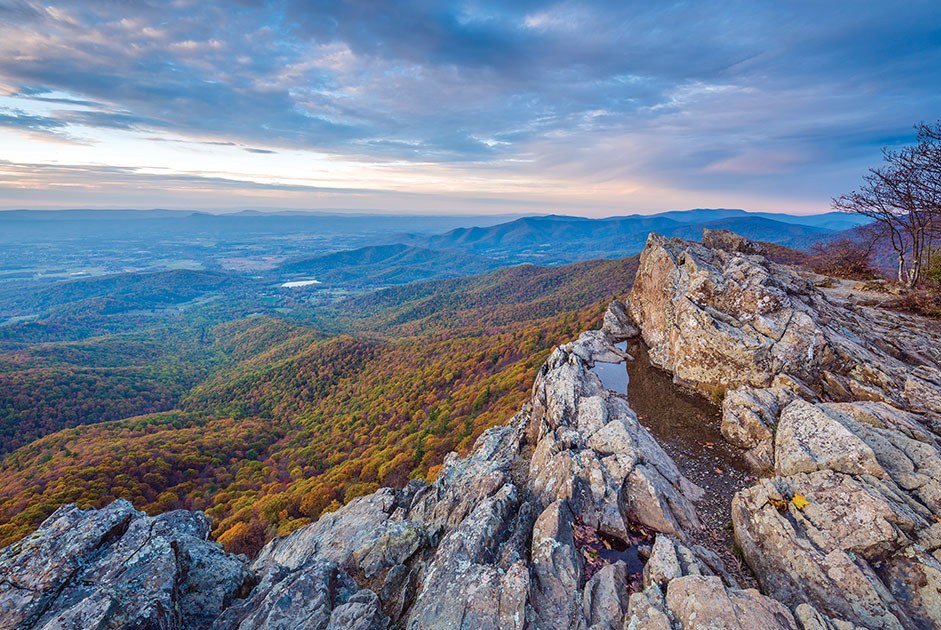History
The Appalachian Trail (A.T.) is the longest marked footpath in the United States. It starts at Springer Mountain in Georgia, it crosses 14 states, six national parks, and eight national forests, ending at Maine’s Mount Katahdin. “Thru-hikers” cover a total of 2,193.1 miles.
The Appalachian Trail was envisioned by Benton Mackaye, a land-use planner. Mackaye, who grew up near Boston, Massachusetts, was an avid mountain climber. After graduating from Harvard in 1900, he and a classmate hiked Vermont’s Long Trail through the Green Mountains, and it was on this trek that Mackaye got the idea for a trail following the Appalachian Mountains from Maine to Georgia. The Journal of the American Institute of Architects editor convinced Mackaye to write an article about his idea. Published in October 1921, “An Appalachian Trail, A Project in Regional Planning” helped solidify Mackaye’s vision. The Appalachian Trail was to be a destination where East Coast city dwellers could get back to nature—a place for recreation, recuperation, and as he described it, “to walk, to see and to see what you see.”
The Hikers
There are two types of Appalachian Trail hikers: section-hikers and thru-hikers. Section-hikers hike the Appalachian Trail in pieces, often over the course of years, whereas thru-hikers take on the entire trail in one trip. Earl Shaffer from York County, Pennsylvania, completed the first known thru-hike in 1948, when people had doubts about whether such an accomplishment was even possible. Starting from Georgia and averaging 16.5 miles a day, he reached Mount Katahdin 124 days later. He caught the bug, and in 1965, he hiked the trail again, this time from Maine to Georgia, making him the first person to walk the trail in both directions. Then, in 1998, at age 79, he hiked it again.
The A.T. sees three-plus million people each year. Serious trekkers who plan on covering many miles start slow, averaging eight to ten miles a day. They will eventually work up to 12 to 16 miles a day. Hiking the entire A.T. is a grueling and demanding endeavor. It requires great physical and mental stamina and determination. The terrain is mountainous in its entirety.
Dangers
Hiking the A.T. can have great benefits for your overall health, but spending lots of time in nature requires special preparations.
The most significant risk to your health and safety while hiking the A.T. is contracting a tick-borne disease. As of 2019, multiple species of ticks can be found in each of the 14 states the A.T. passes through. Although Lyme disease, carried by the deer tick (also known as the black-legged tick), is the most common, there are several tick-borne illnesses present on the A.T. Though tick-borne illnesses are usually very treatable, symptoms can be severe and long-lasting, and a few of the less common ones can be life-threatening.
Norovirus is a highly contagious stomach virus transmitted by contact with an infected person, contaminated food or water, or contaminated surfaces. It is easily spread on parts of the A.T. that experience crowded conditions. Norovirus can cause stomach pain, nausea, and diarrhea. (Not the best situation to be in with no real bathrooms in sight.)
The Appalachian Trail does have its dangers: illness, poisonous snakes, bears, lightning storms…even murder (very unlikely), but the trail does also surely celebrate life! In 1978, thru-hikers Richard and Donna Satterlie found out while hiking in Hot Springs, North Carolina, that Donna was pregnant. She was 7.5 months pregnant by the time she arrived at Mount Katahdin. In honor of their successful completion of the A. T., they named their baby girl Georgia Maine.
Why People Hike
Why hike the A.T. from Georgia to Maine? For some people, it’s a rite of passage, or a way to stay on track mentally, a physical challenge, or maybe a way to heal a broken heart. Some hike the A. T. simply to be in nature and stay off the grid for a while.
What is Trail Magic?
People interpret Trail Magic differently. It can include things like:
- Experiencing something rare, extraordinary, or inspiring in nature.
- Finding what you need most when you least expect it.
- Encountering unexpected acts of generosity that restore one’s faith in humanity.
Acts of generosity in this wild and primitive setting of the Appalachian Trail–where basic amenities of civilization are intentionally absent–are often received in a heightened sense of wonder and gratitude by hikers.



















